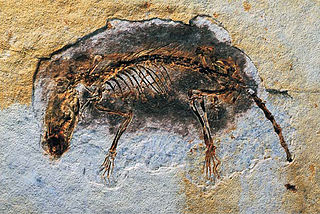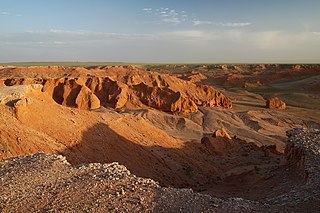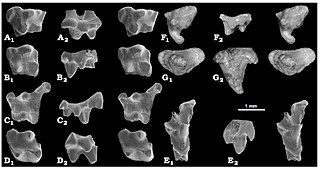
Eomaia is a genus of extinct fossil mammals containing the single species Eomaia scansoria, discovered in rocks that were found in the Yixian Formation, Liaoning Province, China, and dated to the Barremian Age of the Lower Cretaceous about 125 million years ago. The single fossil specimen of this species is 10 centimetres (3.9 in) in length and virtually complete. An estimate of the body weight is 20–25 grams (0.71–0.88 oz). It is exceptionally well-preserved for a 125-million-year-old specimen. Although the fossil's skull is squashed flat, its teeth, tiny foot bones, cartilages and even its fur are visible.

Catopsbaatar is a genus of multituberculate, an extinct order of rodent-like mammals. It lived in what is now Mongolia during the late Campanian age of the Late Cretaceous epoch, about 72 million years ago. The first fossils were collected in the early 1970s, and the animal was named as a new species of the genus Djadochtatherium in 1974, D. catopsaloides. The specific name refers to the animal's similarity to the genus Catopsalis. The species was moved to the genus Catopsalis in 1979, and received its own genus in 1994. Five skulls, one molar, and one skeleton with a skull are known; the last is the genus' most complete specimen. Catopsbaatar was a member of the family Djadochtatheriidae.

Didelphodon is a genus of stagodont metatherians from the Late Cretaceous of North America.

Repenomamus is a genus of opossum- to badger-sized gobiconodontid mammal containing two species, Repenomamus robustus and Repenomamus giganticus. Both species are known from fossils found in China that date to the early Cretaceous period, about 125-123.2 million years ago. R. robustus is one of several Mesozoic mammals for which there is good evidence that it fed on vertebrates, including dinosaurs. Though it is not entirely clear whether or not these animals primarily hunted live dinosaurs or scavenged dead ones, evidence for the former is present in fossilized remains showcasing the results of what was most likely a predation attempt by R. robustus directed at a specimen of the dinosaur Psittacosaurus lujiatunensis. R. giganticus is among the largest mammals known from the Mesozoic era.

Avimimus, meaning "bird mimic", is a genus of oviraptorosaurian theropod dinosaur, named for its bird-like characteristics, that lived in the late Cretaceous in what is now Mongolia, around 85 to 70 million years ago.

Zalambdalestes was a eutherian mammal, most likely not a placental due to the presence of an epipubic bone, living during the Upper Cretaceous in Mongolia.

Pucadelphys is an extinct genus of non-marsupial metatherian. The genus contains a single species, P. andinus. Fossils of Pucadelphys have been found in the Santa Lucía Formation in Tiupampa in Bolivia.

Alphadon is an extinct genus of small, primitive mammal that was a member of the metatherians, a group of mammals that includes modern-day marsupials. Its fossils were first discovered and named by George Gaylord Simpson in 1929.

Archaeornithoides is a genus of maniraptoran theropod dinosaur of the Late Cretaceous of Mongolia.

Bagaceratops is a genus of small protoceratopsid dinosaurs that lived in Asia during the Late Cretaceous, around 72 to 71 million years ago. Bagaceratops remains have been reported from the Barun Goyot Formation and Bayan Mandahu Formation. One specimen may argue the possible presence of Bagaceratops in the Djadochta Formation.
Kuru is a genus of dromaeosaurid theropod from the Late Cretaceous Barun Goyot Formation of Mongolia. The genus contains only a single species, the type species Kuru kulla, which is known from a fragmentary skeleton including a partial skull.

The Djadochta Formation is a highly fossiliferous geological formation situated in Central Asia, Gobi Desert, dating from the Late Cretaceous period, about 75 million to 71 million years ago. The type locality is the Bayn Dzak locality, famously known as the Flaming Cliffs. Reptile and mammal remains are among the fossils that have been recovered from the formation.

Gobiconodon is an extinct genus of carnivorous mammals belonging to the family Gobiconodontidae. Undisputed records of Gobiconodon are restricted to the Early Cretaceous of Asia and North America, but isolated teeth attributed to the genus have also been described from formations in England and Morocco dating as far back as the Middle Jurassic. Species of Gobiconodon varied considerably in size, with G. ostromi, one of the larger species, being around the size of a modern Virginia opossum. Like other gobiconodontids, it possessed several speciations towards carnivory, such as shearing molariform teeth, large canine-like incisors and powerful jaw and forelimb musculature, indicating that it probably fed on vertebrate prey. Unusually among predatory mammals and other eutriconodonts, the lower canines were vestigial, with the first lower incisor pair having become massive and canine-like. Like the larger Repenomamus there might be some evidence of scavenging.
Deltatheroida is an extinct group of basal metatherians that were distantly related to modern marsupials. The majority of known members of the group lived in the Cretaceous; one species, Gurbanodelta kara, is known from the late Paleocene (Gashatan) of China. Their fossils are restricted to Central Asia and North America. This order can be defined as all metatherians closer to Deltatheridium than to Marsupialia.
Ukhaatherium is a now extinct species of mammal that lived during the upper Cretaceous about 84 to 72 million years ago in today's East Asia. It is known above all from the fossil locality Ukhaa Tolgod, Mongolia. An adult Ukhaatherium has an estimated weight of about 32g and bears several similarities to lipotyphlan insectivorans such as the tenrec.
The "Gurlin Tsav" skull is a currently unnamed carnivorous metatherian fossil from the Nemegt Formation of Mongolia. Composed of a single semi-complete skull, this specimen is notable in regards to the evolution and systematics of Metatheria as a whole, and thus nigh-omnipresent in phylogenetic analyses of this group.

Tsagandelta is a genus of deltatheroidean therian mammal that lived in Asia during the Late Cretaceous. Distantly related to modern marsupials, it is part of Deltatheroida, a lineage of carnivorous metatherians common in the Cretaceous of Asia and among the most successful non-theropod carnivores of the region. It represents the first known mammal from the Bayan Shireh Formation.

Holoclemensia is an extinct genus of mammal of uncertain phylogenetic placement. It lived during the Early Cretaceous and its fossil remains were discovered in Texas.

Asiatherium is an extinct genus of mammal, probably belonging to Metatheria. It lived during the Late Cretaceous, and its fossilized remains were discovered in Mongolia.
Albertatherium is an extinct genus of alphadontid metatherians that lived during the Late Cretaceous of North America. The genus contains two species, Albertatherium primus, and Albertatherium secundus. Fossils have been found in the Eagle Formation of Montana and the Milk River Formation of Alberta.


















